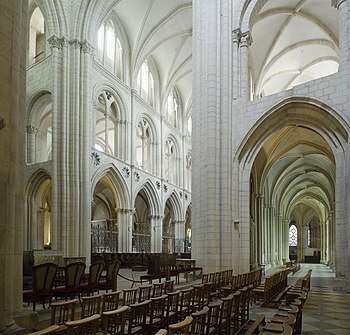From Constantine to Romanesque: The Foundations of Christian Architecture
 Saint-Jacques de Compostelle Church – Example of Romanesque Architecture
Saint-Jacques de Compostelle Church – Example of Romanesque ArchitectureThe history of Christian architecture is a fascinating journey that mirrors the evolution of Western civilization itself. From humble beginnings in secret worship spaces to the grand, fortified churches of the Romanesque period, the architecture of the Christian Church reflects the changing needs, beliefs, and technological advances of the societies it served. This article explores how Christian architecture transitioned from early basilicas to the monumental Romanesque structures that dominated Europe before the advent of Gothic architecture. Each sub-period not only reveals developments in form and structure but also reflects the shifting priorities of Christian worship.
Introduction: Christianity’s Rise in the Roman Empire
In 313 AD, Emperor Constantine issued the Edict of Milan, legalizing Christianity throughout the Roman Empire. This marked a turning point not only for the Christian faith but also for its architectural needs. No longer confined to private homes or secret worship spaces, Christians could now build churches that would serve as prominent places of worship and community gathering. However, without an established architectural style, early Christians adopted and adapted existing Roman civic structures, particularly the basilica.
Key Characteristics of Early Christian BasilicasForm: Based on Roman public halls, these basilicas were rectangular with a central nave flanked by aisles.Functionality: Designed for congregational worship, these early basilicas had simple designs with no significant verticality.Symbolism: The long nave symbolized the pathway to salvation, while the apse (where the altar was located) represented the heavenly realm.Example: Old St. Peter’s Basilica, Rome (c. 319 AD)

One of the most important early Christian basilicas was Old St. Peter’s Basilica, commissioned by Constantine himself. Situated on the supposed burial site of St. Peter, this basilica was designed to house the growing Christian community and served as a model for future churches. Though simple in design compared to later structures, its immense size (about 350 feet long) and spiritual significance cemented its place in Christian history. The building’s form—a wide central nave with side aisles and a clerestory to admit light—became the blueprint for early Christian architecture.
Byzantine Influence and the Eastern ChurchWhile Christianity was solidifying its architectural language in the West, a different influence was taking shape in the Eastern Roman Empire, particularly after the division between the Eastern and Western Churches. Centered in Constantinople, the Byzantine Church developed a unique architectural style that emphasized verticality, domes, and intricate mosaics.
Key Characteristics of Byzantine Architecture
Centralized Plans: Unlike the longitudinal basilicas of the West, Byzantine churches often had a centralized layout with a dominant dome, symbolizing heaven.Domes: The Byzantine innovation of placing a large, central dome on a square base (using pendentives) allowed for grand, open interior spaces.Mosaics: Interiors were lavishly decorated with mosaics depicting religious scenes, intended to inspire contemplation of the divine.Example: Hagia Sophia, Constantinople (c. 537 AD)

Commissioned by Emperor Justinian I, the Hagia Sophia stands as a masterpiece of Byzantine architecture. Its massive central dome, 100 feet in diameter and 180 feet high, appears to float above the worship space, filling the interior with light. The combination of engineering ingenuity and spiritual intent created a structure that was both a symbol of imperial power and divine authority. Hagia Sophia influenced Christian architecture for centuries and was regarded as the greatest church in Christendom until the construction of St. Peter’s Basilica in the 16th century.
The Split of East and West: Diverging PathsThe formal division between the Eastern Orthodox Church and the Roman Catholic Church in 1054 (the Great Schism) not only split Christianity but also solidified distinct architectural traditions. The Byzantine East continued its emphasis on domes and mosaics, while the West began to develop its own architectural language that would eventually lead to Romanesque and Gothic styles.
The Rise of Romanesque ArchitectureAs Europe stabilized in the aftermath of the collapse of the Western Roman Empire, a new architectural style emerged in the 10th and 11th centuries: Romanesque. The Romanesque period saw the construction of massive, fortress-like churches and cathedrals that reflected both the growing power of the Church and the need for protection in a still-volatile world. The style is called “Romanesque” because it relied on elements from Roman architecture, particularly the round arch and barrel vault.
Key Characteristics of Romanesque ArchitectureThick Walls and Heavy Construction: Romanesque churches were solid, with thick walls to support stone roofs and to protect against external threats.Barrel Vaults and Rounded Arches: Borrowed from Roman engineering, these features created a heavy, enclosed feeling inside the church.Limited Windows: Due to the structural limitations of the barrel vault, Romanesque buildings had small windows, resulting in darker interiors.Sculptural Decoration: While interior spaces were dark, exteriors were richly decorated with stone carvings, often depicting biblical scenes and moral lessons.Example: Abbey Church of Sainte-Foy, Conques (c. 1050-1130 AD)

A quintessential Romanesque structure, the Abbey Church of Sainte-Foy in France, was built to accommodate pilgrims traveling along the Camino de Santiago. Its massive stone structure, rounded arches, and small windows are typical of the Romanesque style. Particularly notable is its large tympanum above the main entrance, depicting the Last Judgment, a common theme in Romanesque church decoration intended to remind the faithful of the consequences of sin and the rewards of salvation.
Example: Durham Cathedral, England (c. 1093-1133 AD)

Durham Cathedral is one of the finest examples of Norman Romanesque architecture in England. Its massive, rib-vaulted ceilings and thick, towering piers represent the Romanesque emphasis on strength and solidity. However, Durham also foreshadows the coming Gothic innovations, as it was one of the first cathedrals to experiment with pointed arches, a key feature of the later Gothic style.
By the late 11th century, the limitations of Romanesque architecture began to frustrate architects and religious leaders. The thick walls and barrel vaults, while solid, allowed for only small windows and dark interiors—hardly conducive to the Church’s desire to fill their worship spaces with the light of God. Additionally, Romanesque buildings, though grand, lacked the verticality that later architects would use to inspire a sense of divine transcendence. This need for greater height and light led to the development of Gothic architecture.
Key Innovations that Led to the Gothic StylePointed Arches: By distributing weight more efficiently, pointed arches allowed for taller buildings and wider, more open interiors.Ribbed Vaults: A refinement of the barrel vault, ribbed vaults provided greater structural support while reducing the need for massive walls.Flying Buttresses: This external support system enabled architects to construct taller walls with larger windows, revolutionizing the interior light of churches.Example: Saint-Étienne, Caen (c. 1063-1130 AD)

The Abbey of Saint-Étienne in Normandy was one of the first major Romanesque churches to experiment with ribbed vaulting and pointed arches, both of which became key elements of the Gothic style. While still Romanesque in its thick walls and relatively modest windows, Saint-Étienne represented the transition between the two architectural periods, laying the groundwork for the soaring heights and luminosity of Gothic cathedrals.
Conclusion: From Roman to Romanesque, and BeyondThe evolution of Christian architecture from the early basilicas of Constantine’s era to the monumental Romanesque churches of the 11th century reveals a continuous search for greater expression of faith through building design. Each architectural period—from the early, simple basilicas to the domed grandeur of Byzantine churches to the fortified Romanesque churches—responded to the needs and circumstances of its time. Romanesque architecture, with its weighty construction and dark interiors, was monumental in scope but limited in expression. The transition to Gothic architecture, marked by engineering innovations like pointed arches, ribbed vaults, and flying buttresses, allowed for buildings that were both structurally innovative and spiritually uplifting. In this context, the Gothic cathedrals that followed represent not just an architectural shift but a culmination of centuries of Christian architectural experimentation.



